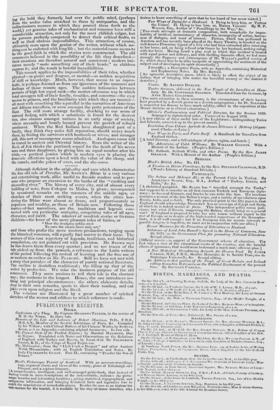Although deficient in the origh.ality and race which characterize the
fine old talc of Peredur, Nr. SNOWE'S Rhine is a very various and entertaining work, alike useful to fireside readers and to per- sons who propose an excursion to the banks of the "exulting and abounding river." The history of every city, and of almost every building of note, front Cologne to Mainz, is given ; accompanied by occasional remarks on the manners of the middle ages, or sketches of their most striking events, when the cities bor- dering the Rhine were almost as dense, and proportionately RS populous and wealthy, us those of Britain now. Following these matter-of-fact narratives, are the traditions and legend's con- nected with any particular antiquity, comprising tales of all ages, character, and merit. The admirer of monkish stories. or German diablerie—the lover of the more pleasant tales of fairies, or " How the drudging goblin swet To earn the cream-bowl duly set," and those who prefer the more modern productions, verging upon the historical romance, will equally find matter to their taste. The sources of' this vast repertory of legends, traditions and historical compilation, are not pointed out with precision. ill.. SsowE says he has drawn them from every quarter ; and we see traces of the tale picked up from the peasant, a reference to the Latin writers lithe period following the revival of learning and the free use of so modern an author as Mr. PLANCHL Still we have not met with a story that partakes of the character of purely national literature. The outline is doubtless traditional ; the filling up that of the writer by profession. We miss the business purpose of' the old romancers. They seem anxious to tell their tale in the shortest way; the moderns in the longest. Hence, the one introduces no- thing but principal circumstances ; the others elaborate details, drop in their own remarks, quote to show their reading, and cut jokes even upon religion and the Devil.
The volumes are illustrated by a great number of spirited sketches of the scenes and edifices to which reference is made.


























 Previous page
Previous page